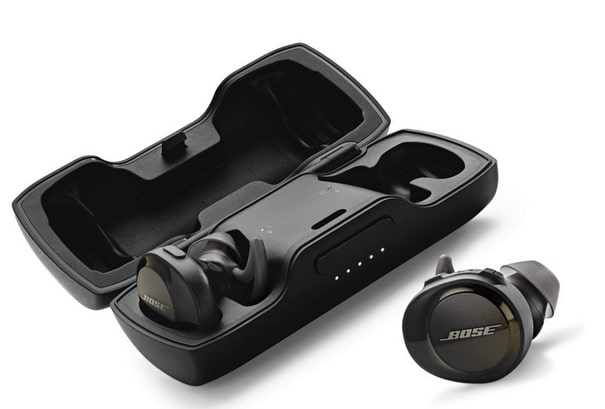By David H. Kirkwood
HOUSTON—David Eagleman, PhD, and his graduate student Scott Novich at Baylor College of Medicine are working alongside a team of engineering undergraduates at Rice University to develop a high-tech garment known as the VEST (Versatile Extra-Sensory Transducer) that would enable people who are deaf in both ears to understand speech by feeling vibrations rather than hearing the words.

The latest prototype of the VEST and a schematic of how it works.
Figure from Scott Novich and David Eagleman.
The theory underlying the VEST is known as “sensory substitution.” The idea is that someone with a defective sensory modality—hearing, in this case—can substitute a normally functioning sensory modality—feeling—to obtain speech information via the skin.
In an e-mail interview on April 19 with this blog, Novich, a doctoral student in electrical and computer engineering, explained how the VEST functions. Novich, who works closely with Eagleman who heads the project, said:
“The VEST uses a smartphone to record sound and converts this sound data (in real-time) to a form that is suitable for encoding to the skin using vibration. Touch receptors in the skin that are tuned to detect vibration convert this information to electrical signals that are then sent to the brain. Enough information is captured in this process to retain intelligible speech information.”
The VEST, which is not yet ready for consumer use, can be worn either over or under a shirt or blouse.
TESTING UNDERWAY
Early experiments conducted by Eagleman and Novich with deaf subjects wearing the VEST have shown some promising results.
Novich described a study in which deaf subjects wearing the VEST are first given a set of 50 single-syllable, phonetically balanced words (PB-K). After this training period, the subjects are given a completely new set of words. Novich said, “The cool result is that we find that people can correctly guess new words at a higher rate than they could by chance. This is evidence that the device should work.”
Novich, whose responsibilities include devising new algorithms for the VEST to use in translating words into vibration, said, “This experiment is used to show that people can: (1) actually identify patterns as words, and (2) generalize the underlying patterns to recognize new words.”
Next, he said, “We’re kicking off long-term testing to see how long it would take a person to get the point of, say, being able to follow a lecture. This will probably require some fairly intensive training of someone wearing the device for prolonged periods of time over the course of each day.”
POTENTIAL ADVANTAGES OVER IMPLANTS
Those involved with developing the VEST contend that it has some possible advantages over cochlear implants in meeting the needs of the 2 million or more functionally deaf people in the United States and an estimated 53 million worldwide
In the abstract of their presentation on the “vibratory vest” for Neuroscience 2014, the conference of the Society for Neuroscience, Eagleman and Novich wrote, “The cochlear implant is an effective solution for regaining hearing; however, such implants are expensive, require invasive surgery, and have low efficacy in early-onset deaf adults. Given this, many deaf individuals would benefit from a hearing replacement that has low cost, does not involve an invasive procedure, and may have a higher efficacy for early-onset deaf adults.”
Cochlear implantation tends to cost in the range of $50,000-$60,000, which is very often covered by insurance. As for the VEST, Novich said his best “current guess” is about $3000. As for when it might be available, he estimated about April 2016
MARKETING ON THEIR MIND
While it is uncertain when, or even if, the VEST will come to market, that’s clearly what its advocates have in mind. Along with Eagleman and Novich, they include several electrical and computer engineering students at Rice who calls themselves the Eagleman Substitution Project (ESP) team. Among them are six undergraduates–Zihe Huang, Evan Dougal, Eric Kang, Edward Luckett, Abhipray Sahoo, and John Yan—and Gary Woods, PhD, a Rice professor in computer technology who is the team’s adviser.
Last year, the team raised about $50,000 on Kickstarter, which Novich said, “has gone towards compensating participants… and working to refine the prototype to be inconspicuous and light-weight.”
Asked if the VEST will be covered by Medicare and other insurance, as cochlear implants are, he said, “This is a prospect we’re excited about, but we are only now dipping our toe into this with regard to FDA approval and coverage.”
If the device does become available to the public, will audiologists and physicians be involved? “Absolutely,” said Novich, “especially if it is treated as a regulated medical device.” He added, “We’ll be working closely with audiologists for clinical testing and possibly distribution. I’m looking forward to seeing what results we get out of this over the whole spectrum of the hearing-loss population (degree of hearing loss, reason for hearing loss, age, linguistic-background, etc.).”
VEST FEATURED IN TED TALK
One of the most valuable assets that the VEST has going for it is the man behind the project, Dr. David Eagleman.
The 44-year-old New Mexico native, who directs a research laboratory at Baylor College of Medicine, is not just another neuroscientist. He is author of a best-selling novel, Sum: Forty Tales from the Afterlives, and influential non-fiction books, including Why the Net Matters: How the Internet Will Save Civilization and Incognito: The Secret Lives of the Brain. He has been profiled in the New Yorker magazine, appeared on The Colbert Report and Nova Science Now, will host a six-hour PBS series on the brain, and was selected in 2011 by Houston Magazine as one of that city’s most stylish men. This year, he will be be hosting a six-hour series on the
In March 2014, Eagleman introduced the VEST to the world in a compelling TED (technology, entertainment, design) Conference talk entitled “Can We Create New Senses for Humans?,” which has been viewed by nearly 900,000 people online.









